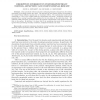Free Online Productivity Tools
i2Speak
i2Symbol
i2OCR
iTex2Img
iWeb2Print
iWeb2Shot
i2Type
iPdf2Split
iPdf2Merge
i2Bopomofo
i2Arabic
i2Style
i2Image
i2PDF
iLatex2Rtf
Sci2ools
61
Voted
SIAMAM
2002
2002
Desorption Overshoot in Polymer-Penetrant Systems: Asymptotic and Computational Results
Many practically relevant polymers undergoing desorption change from the rubbery (saturated) to the glassy (nearly dry) state. The dynamics of such systems cannot be described by the simple Fickian diffusion equation due to viscoelastic effects. The mathematical model solved numerically is a set of two coupled PDEs for concentration and stress. Asymptotic solutions are presented for a moving boundary-value problem for the two states in the short-time limit. The solutions exhibit desorption overshoot, where the penetrant concentration in the interior is less than that on the surface. In addition, it is shown that if the underlying time scale of the equations is ignored when postulating boundary conditions, nonphysical solutions can result. Key words. asymptotic expansions, desorption, moving boundary-value problems, perturbation methods, polymer-penetrant systems, finite-element method AMS subject classifications. 35B20, 35C15, 35C20, 35K60, 35R35, 65N30, 74D10, 76M10, 76R99, 80A22 PII....
| Added | 23 Dec 2010 |
| Updated | 23 Dec 2010 |
| Type | Journal |
| Year | 2002 |
| Where | SIAMAM |
| Authors | David A. Edwards, Richard A. Cairncross |
Comments (0)

